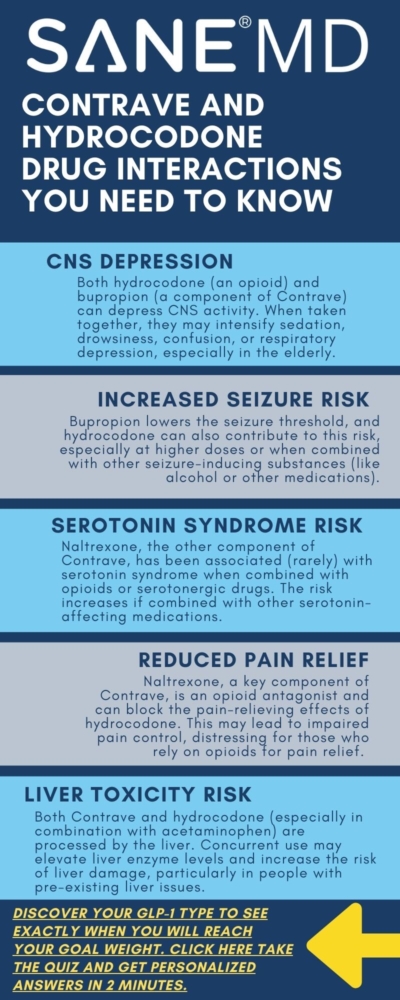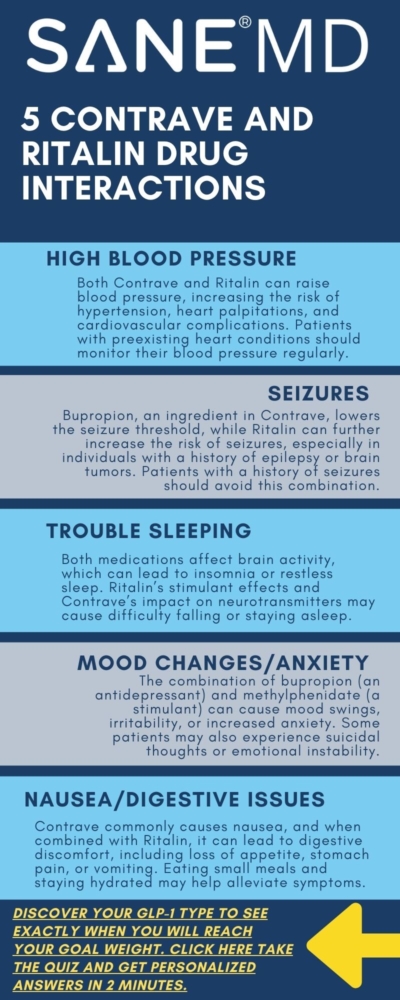Contrave and Antibiotics Drug Interactions: What to Know

Contrave, a combination of bupropion and naltrexone, is prescribed to assist with weight loss in certain adults who are struggling with obesity or overweight conditions accompanied by related health issues. Understanding potential Contrave and antibiotics drug interactions is crucial for ensuring patient safety and therapeutic efficacy.
This article explores specific antibiotics known to interact with Contrave, the mechanisms behind these interactions, and essential considerations for patients and healthcare providers.
Key Takeaways:
- Specific Antibiotic Interactions: Certain antibiotics, such as clarithromycin, can interact with Contrave, potentially increasing the risk of side effects.
- Health Monitoring: Patients should monitor their blood pressure and blood sugar levels while on Contrave, especially when taking other medications.
- Consult Healthcare Providers: It’s imperative to inform your doctor about all medications you’re taking to manage potential drug interactions effectively.
Understanding Contrave and Its Components
Contrave is a prescription medication designed to assist with weight loss in compatible adults with obesity or those who are overweight and have at least one weight-related health condition, such as high blood pressure, type 2 diabetes, or high cholesterol.
Take Contrave as part of a reduced-calorie diet and exercise plan to maximize results. How does Contrave work for weight loss?
Contrave contains two active ingredients that work together to affect the brain’s appetite control and reward system:
- Bupropion – This medication is classified as an atypical antidepressant and is also used to treat depression and bipolar disorder in some cases. Bupropion inhibits the reuptake of norepinephrine and dopamine, two neurotransmitters involved in regulating mood, energy levels, and hunger. By increasing the availability of these neurotransmitters, bupropion helps reduce food cravings and can contribute to appetite suppression. However, this mechanism may also increase the risk of suicidal thoughts, which is why Contrave carries a boxed warning alerting doctors to this possibility, particularly in younger patients.
- Naltrexone – Commonly used to help people with opioid withdrawal and alcohol dependence, naltrexone works as an opioid antagonist. It blocks opioid receptors in the brain, reducing the pleasure associated with eating highly palatable foods. This action helps limit binge-eating behaviors and promotes better portion control.
It is important to note that individuals who suddenly stop drinking alcohol while taking Contrave may face an increased risk of seizures. This is particularly relevant for those with alcohol use disorder, as abruptly ceasing alcohol consumption can lead to severe withdrawal symptoms.
Therefore, healthcare providers may advise against taking Contrave during this period. Patients who have suddenly stopped drinking alcohol should inform their healthcare provider, as this can influence the decision to prescribe Contrave due to the heightened risk of seizures.
According to the FDA, Contrave’s combination of these two ingredients alters the brain’s hunger and reward responses, making it easier for individuals to adhere to dietary changes necessary for weight loss (FDA).
While effective, Contrave is not suitable for everyone. Individuals with seizure disorder, severely high blood pressure, or a history of certain drug interactions should avoid taking it, as these conditions may increase the risk of serious side effects, including irregular heartbeat and chest pain. Additionally, high-fat meals should be avoided while taking Contrave, as they can increase the risk of side effects by altering the absorption rate of the medication.
Patients should always tell their doctor about any medications they are currently taking, including over-the-counter drugs and other medicines, to minimize possible interactions that could compromise safety or effectiveness.
Antibiotics and Contrave Interactions
Certain antibiotics may interact with Contrave, potentially increasing the risk of side effects or diminishing the drug’s effectiveness. If you are prescribed antibiotics while taking Contrave, it is crucial to inform your doctor. They may recommend alternative antibiotics or adjust your Contrave dosage to minimize interactions.
For example, antibiotics like clarithromycin can affect liver function, which may be compounded by naltrexone in Contrave. Additionally, linezolid, an antibiotic with monoamine oxidase inhibitor (MAOI) properties, can interact with bupropion, increasing the risk of hypertensive reactions.
Open communication with your healthcare provider ensures that any necessary adjustments are made to maintain the safety and efficacy of your treatment plan.
Note: While clarithromycin and linezolid are identified as antibiotics that may interact with Contrave, specific interactions with other antibiotics are not well-documented. (Drugs.com) Therefore, it’s essential to consult your healthcare provider regarding any antibiotics prescribed during Contrave treatment.
Understanding Contrave and Drug Interactions
Contrave is a prescription medication that combines two active ingredients, bupropion and naltrexone, to aid in weight loss and weight management. As with any medication, understanding how Contrave interacts with other drugs is crucial.
Drug interactions can increase the risk of side effects, reduce the effectiveness of Contrave, or even lead to serious health problems. This includes interactions with prescription medications, over-the-counter (OTC) drugs, vitamins, and supplements. For instance, certain drug interactions may affect how Contrave is metabolized in the body, potentially leading to increased side effects or diminished therapeutic effects.
Thus, it’s crucial to inform your healthcare provider about all the medications and supplements you are taking to effectively manage these interactions.
Health History and Conditions
Before starting Contrave, it’s vital to discuss your health history and any existing conditions with your doctor. Certain health conditions, such as high blood pressure, eating disorders, or a history of seizures, can influence how Contrave works or increase the risk of adverse effects.
For example, individuals with high blood pressure need careful monitoring as bupropion, one of the components of Contrave, can elevate blood pressure. Similarly, those with a history of eating disorders or seizures may face heightened risks when taking Contrave.
Your doctor will evaluate your health history to determine if Contrave is a safe and suitable option for you, ensuring that any potential risks are managed appropriately.
Medications that Interact with Contrave
Several medications can interact with Contrave, leading to increased risks of side effects or reduced effectiveness. Notable interactions include:
- Opioids: Combining Contrave with opioids like morphine, codeine, or fentanyl can lead to side effects such as nausea, vomiting, and dizziness. Naltrexone, a component of Contrave, blocks opioid receptors, which can precipitate withdrawal symptoms in individuals dependent on opioids.
- Monoamine Oxidase Inhibitors (MAOIs): Contrave can interact with MAOIs, which can cause serious side effects, including high blood pressure and seizures. Therefore, it is recommended that MAOIs be avoided for at least 14 days before and after Contrave.
- Certain Antidepressants: Taking Contrave with selective serotonin reuptake inhibitors (SSRIs) or other antidepressants, such as Effexor, Lexapro, Zoloft, Cymbalta, and Prozac, can increase the risk of side effects like nausea and dizziness. This is due to the combined effects on neurotransmitter levels in the brain.
- Beta-blockers: Contrave combined with beta-blockers can elevate the risk of high blood pressure and heart rate issues. This interaction necessitates careful monitoring and possible dosage adjustments. See our guide for more about how Contrave can increase blood pressure.
Always keep your healthcare provider informed about all the medications you are currently taking to avoid potential interactions and ensure the safe use of Contrave.
Monitoring and Precautions
Your doctor will monitor your progress and adjust your dosage as needed to ensure the safe and effective use of Contrave. It is essential that you adhere to your doctor’s instructions and attend regular follow-up appointments.
Additionally, be aware of the following precautions:
- Allergic Reactions: If you notice signs of an allergic reaction, such as hives, itching, or difficulty breathing, seek medical help right away. A serious allergic reaction can be severe and require prompt treatment.
- Serious Skin Reactions: Contrave can cause serious skin reactions, including Stevens-Johnson syndrome. Symptoms like blistering, peeling, or loosening of the skin necessitate immediate medical attention.
- Low Blood Sugar: Contrave can increase the risk of low blood sugar in individuals with diabetes. To prevent hypoglycemia, monitor your blood sugar levels regularly and adjust your treatment plan as needed.
- Bipolar Disorder: Contrave can increase the risk of manic episodes in people with bipolar disorder. If you have a history of bipolar disorder, inform your doctor before starting Contrave to manage this risk effectively.
- Opioid Withdrawal: Contrave can precipitate opioid withdrawal symptoms. If you are taking opioids, inform your doctor to ensure appropriate management and avoid withdrawal complications.
By understanding Contrave and its interactions with other medications, you can minimize the risk of side effects and ensure the safe and effective use of the medication.
To optimize your treatment plan, always inform your doctor about your health history, medications, and any concerns you may have.

Frequently Asked Questions (FAQ) About Contrave and Drug Interactions
Understanding how Contrave interacts with other medications is essential for ensuring both safety and effectiveness.
Below are answers to common questions regarding Contrave and potential drug interactions. If you have concerns about a specific medication, always consult your healthcare provider before making any changes to your treatment plan.
1. What medications should not be taken with Contrave?
Certain medications should be avoided while taking Contrave due to the risk of serious drug interactions. Monoamine oxidase inhibitors (MAOIs), such as phenelzine and tranylcypromine, should not be taken within 14 days of starting or stopping Contrave due to the risk of hypertensive reactions. Opioid-based medications, including oxycodone and morphine, should also be avoided since naltrexone blocks opioid receptors, potentially leading to withdrawal symptoms.
Additionally, medications that lower the seizure threshold, such as antipsychotics and corticosteroids, may increase the risk of seizures when taken with Contrave. Always tell your doctor about all other medications you are taking, including over-the-counter drugs, to prevent possible interactions.
2. Can I take azithromycin with Contrave?
Azithromycin, a commonly prescribed antibiotic, is not known to have any serious drug interactions with Contrave. However, some individuals may experience gastrointestinal side effects, such as nausea or upset stomach, which could be compounded by Contrave.
Additionally, since Contrave contains bupropion, which can increase blood pressure, patients who have high blood pressure or heart conditions should consult their healthcare provider before taking both medications together.
If you experience any unusual symptoms, such as dizziness, chest pain, or rapid heart rate, contact your doctor immediately.
3. Can you take ibuprofen while taking Contrave?
Ibuprofen, a nonsteroidal anti-inflammatory drug (NSAID), is generally safe to use with Contrave, but some precautions should be considered. Both ibuprofen and Contrave have the potential to impact the liver, particularly in individuals with preexisting liver conditions or those who drink alcohol frequently.
Additionally, NSAIDs like ibuprofen can elevate blood pressure, so individuals with severely high blood pressure or a history of cardiovascular issues should use ibuprofen cautiously. If long-term pain management is needed, it is best to discuss other medicines or alternative treatment options with a healthcare provider.
4. Is it okay to take amoxicillin with bupropion?
Amoxicillin, a widely used antibiotic, does not have a life-threatening interaction with bupropion, one of Contrave’s active ingredients. However, both medications can cause gastrointestinal discomfort, and in rare cases, serious skin reactions, such as rashes or hives, may occur.
While there is no direct contraindication, patients with a history of a serious allergic reaction to either medication should proceed with caution.
If you experience symptoms such as skin rash, swelling, or flu-like symptoms, seek medical attention promptly.
Conclusion
Understanding how Contrave and antibiotics drug interactions can affect treatment outcomes is essential for ensuring safety and effectiveness. While most antibiotics do not significantly interact with Contrave, certain medications—such as clarithromycin and linezolid—can increase the risk of side effects like liver damage, elevated blood pressure, and seizures.
Patients should always tell their doctor about any other drugs they are taking, including over-the-counter drugs, to manage possible interactions effectively.
Additionally, those with health conditions such as high blood pressure, seizure disorder, or bipolar disorder should exercise caution when starting Contrave treatment. Taking Contrave safely requires dose adjustments in some cases, particularly when using medications that may interact with Contrave or affect its metabolism.
By following your healthcare provider’s guidance, monitoring for potential side effects, and staying informed about certain drug interactions, patients can minimize risks and optimize the benefits of Contrave as part of their weight loss journey.

Contrave and Hydrocodone Drug Interactions: Risky Combo?

Combining medications can offer therapeutic benefits, but it can also increase the risk of serious side effects. One such potential interaction that has raised concerns is between Contrave and hydrocodone. While Contrave—an FDA-approved medication for chronic weight management—has helped certain individuals achieve clinically meaningful weight loss, its active components, naltrexone and bupropion, may interact dangerously with opioids like hydrocodone.
This article explores the possible Contrave and hydrocodone drug interactions, focusing on safety risks, underlying pharmacology, and what patients and healthcare providers need to know. Understanding this risky combo is crucial, especially for individuals with a history of opioid dependence, psychiatric illness, or conditions like bipolar disorder and seizure disorder.
Key Takeaways
- Combining Contrave and hydrocodone can trigger opioid withdrawal symptoms and increase the risk of seizures, making this interaction potentially dangerous.
- Contrave’s component naltrexone blocks opioid receptors, while bupropion lowers the seizure threshold—both contribute to heightened risk when used with opioids.
- Patients should consult their healthcare provider before combining Contrave with any other medications, especially opioids or over-the-counter drugs, due to the potential for serious adverse reactions.
Summary Table of Contrave and Hydrocodone Drug Interactions
| Interaction Aspect | Details |
|---|---|
| Primary Concern | Naltrexone blocks opioid receptors, while bupropion lowers the seizure threshold. Combining Contrave with hydrocodone can lead to serious adverse effects. |
| Opioid Withdrawal Risk | Sudden onset of withdrawal symptoms (e.g., nausea, anxiety, sweating, muscle aches) if opioids are still in the system when starting Contrave. |
| Seizure Risk | Bupropion increases seizure risk, especially with high doses or when combined with opioids, alcohol, or other CNS depressants. |
| Impact on Pain Relief | Hydrocodone may become ineffective due to opioid receptor blockade by naltrexone. |
| Neuropsychiatric Concerns | Increased risk of mood changes, hallucinations, and other serious neuropsychiatric adverse events. |
| Cardiovascular Effects | Contrave may raise blood pressure and heart rate. Interaction with hydrocodone could worsen cardiovascular instability. |
| Boxed Warning | Contrave includes a boxed warning advising against use in patients currently taking opioids or undergoing opioid withdrawal. |
| Recommendation | Do not take Contrave with hydrocodone or any opioid. Patients must be opioid-free for at least 7–10 days before starting Contrave. |
| Monitoring Required | Close monitoring by a healthcare provider is necessary if there’s any risk of opioid exposure or seizure susceptibility. |
What Is Contrave?
Contrave is a prescription medication approved for chronic weight management in certain obese patients or overweight adults with at least one weight-related condition, such as high blood pressure or type 2 diabetes.
It contains two active ingredients:
- Bupropion hydrochloride, an atypical antidepressant also used in smoking cessation treatment.
- Naltrexone, an opioid receptor antagonist originally used to treat opioid dependence and alcohol use disorder.
Together, naltrexone and bupropion (or bupropion naltrexone) target the brain’s reward and appetite centers, supporting behavior change and helping patients follow a reduced-calorie diet.
How Contrave Works
- Bupropion inhibits the reuptake of dopamine and norepinephrine, affecting the dopamine agonist effects involved in appetite and mood regulation.
- Naltrexone blocks opioid receptors in the brain, which may help reduce cravings and reward-driven eating.
But this unique mechanism also introduces risks, especially when other drugs are added to the mix.
Hydrocodone: An Opioid Painkiller
Hydrocodone is a widely prescribed opioid used for moderate to severe pain. It functions as a central nervous system depressant by binding to opioid receptors in the brain and spinal cord.
The presence of naltrexone in Contrave can block these receptors, making hydrocodone less effective and potentially triggering opioid withdrawal symptoms in dependent individuals.
Additionally, combining hydrocodone with bupropion therapy may increase the risk of seizures due to opposing effects on the central nervous system.
Contrave and Hydrocodone Drug Interactions
The combination of Contrave and hydrocodone is strongly discouraged due to the pharmacodynamic conflict between naltrexone bupropion and opioid medications. Hydrocodone, a commonly prescribed opioid for pain, relies on mu-opioid receptors to produce analgesia and euphoria.
Naltrexone, a key component in Contrave, is an opioid antagonist that blocks these receptors, while bupropion carries a significant risk of lowering the seizure threshold.
When these substances are taken together, the result can be a cascade of adverse reactions ranging from ineffectiveness of pain relief to potentially life-threatening complications like opioid withdrawal and seizures.
1. Opioid Withdrawal
Naltrexone binds competitively to opioid receptors and can displace opioids like hydrocodone, abruptly halting their effect.
This interaction can lead to the sudden onset of opioid withdrawal symptoms, which may include:
- Restlessness and anxiety
- Nausea, vomiting, and diarrhea
- Excessive sweating and chills
- Muscle cramps and body aches
- Increased heart rate and blood pressure
For individuals with even mild or recent opioid dependence, this reaction can be intense and debilitating.
The symptoms of opioid withdrawal typically begin within minutes to hours after taking Contrave if hydrocodone is still present in the body.
Dr. Matthew Olesiak, MD, Chief Medical Director at SANE MD, emphasizes:
“Taking naltrexone while opioids are still in the body can precipitate an abrupt and severe withdrawal reaction. Patients must be opioid-free for at least 7–10 days before starting Contrave.”
Because of this, the medication guide for Contrave explicitly advises patients and clinicians to confirm opioid abstinence before initiating treatment. The boxed warning alerts doctors to the dangers of combining opioid use with naltrexone systemic exposure.
For patients unknowingly using hydrocodone or those who take over-the-counter drugs with opioid-like effects, unintentional opioid withdrawal remains a real concern. This underlines the importance of full medication disclosure and comprehensive screening before starting Contrave treatment.
2. Increased Risk of Seizures
The second major concern in this drug combination involves bupropion, an atypical antidepressant and dopamine-norepinephrine reuptake inhibitor that is known to lower the seizure threshold.
When combined with opioids—or in patients with certain medical histories—the risk of seizures increases substantially.
This risk is dose-related, meaning higher bupropion doses or rapid titration of Contrave increase the likelihood of convulsions.
The FDA has reported seizure incidence rates of approximately 0.1% at recommended doses, but this number rises with co-use of other drugs, misuse, or predisposing conditions such as:
- A personal or family history of seizure disorder
- History of head trauma or brain tumor
- Eating disorders like bulimia or anorexia nervosa
- Concurrent use of alcohol, systemic corticosteroids, or stimulants
- Use of other medications that affect central nervous system excitability
Combining hydrocodone and Contrave exacerbates these dangers.
Opioids can alter respiratory patterns and oxygen levels, potentially destabilizing brain function and further reducing the seizure threshold.
This is especially critical in patients taking bupropion for smoking cessation or to treat depression, where baseline seizure risk may already be elevated due to medication load or underlying conditions.
3. Blood Pressure Concerns
Another pressing issue in the interaction between Contrave and hydrocodone is their combined effects on the cardiovascular system. Contrave treatment has been associated with increases in both systolic and diastolic blood pressure, particularly in the early stages of use. While this elevation is generally mild, it may be dangerous for individuals with high blood pressure, severe hepatic impairment, or known cardiovascular disease.
The mechanisms behind this rise in blood pressure include the stimulant-like action of bupropion, which can increase sympathetic nervous system activity, and naltrexone, which may amplify these effects in susceptible individuals. When hydrocodone is added to the mix, its central nervous system depressant properties can cause unpredictable interactions, especially with heart rate and respiratory patterns.
In some cases, this can result in:
- Hypertensive episodes
- Heart palpitations
- Chest discomfort
- Fluctuations in oxygen saturation or blood carbon dioxide levels
Dr. Olesiak notes:
“Contrave can raise blood pressure and heart rate, so close monitoring is crucial for patients on hypertensive medications or with preexisting cardiovascular conditions.”
Because many individuals pursuing chronic weight management may already be managing high blood pressure, obese patients must be evaluated carefully before initiating therapy. Regular monitoring is recommended, especially during the start of Contrave treatment, to ensure a safe cardiovascular response.
Clinicians are advised to adjust treatment based on individual risk factors and, when necessary, reduce the dose or modify the timing of extended-release tablets to minimize peaks in systemic exposure.
Additional Risks and Considerations
While the most prominent dangers of combining Contrave and hydrocodone involve opioid withdrawal and seizures, there are several other drug interaction concerns that warrant equal attention. From allergic responses to systemic complications, these interactions can present suddenly and with serious consequences—particularly in patients with predisposing health factors or those taking other medications.

Risk of Allergic Reaction
Using multiple medications, especially those that act on the central nervous system or immune pathways, can increase the likelihood of a severe allergic reaction. Individuals taking Contrave—especially when combined with opioids like hydrocodone—should be alert to early signs of hypersensitivity, which may include:
- Skin rash or hives
- Itching or swelling, particularly around the face, lips, or throat
- Wheezing, difficulty breathing, or tightness in the chest
These symptoms may indicate a systemic allergic reaction requiring emergency medical attention. While rare, allergic responses may result from either the naltrexone bupropion formulation itself or from a Contrave interaction with another agent—prescription, or otherwise.
Because opioids like hydrocodone are known to release histamine in some users, co-use with Contrave can amplify this response and potentially increase the risk of an allergic cascade. Individuals with a history of drug sensitivities should inform their healthcare provider before starting Contrave treatment or combining it with other drugs.
Adverse Reactions and Side Effects
The FDA has issued clear warnings about the adverse reactions associated with combining Contrave with other drugs that lower the seizure threshold, such as hydrocodone. This combination may increase the risk of serious neuropsychiatric adverse events, including:
- Agitation, mood swings, and emotional instability
- Disorientation, delusional thinking, or hallucinations
- Panic attacks or suicidal ideation
- Cardiovascular symptoms like rapid heartbeat or chest pain
These side effects may emerge more rapidly or with greater severity when Contrave is combined with opioids, alcohol, or systemic corticosteroids, all of which can interact with the bupropion naltrexone mechanism.
In placebo-controlled trials, patients treated with Contrave reported adverse reactions such as:
- Nausea (especially in the early weeks of treatment)
- Dizziness, light-headedness, or blurred vision
- Insomnia, anxiety, or vivid dreams
- Elevated blood pressure and heart rate
These findings are detailed in a randomized, phase 3 trial published in Obesity, which evaluated the safety and efficacy of naltrexone sustained-release (SR) and bupropion SR combination therapy. The study reported that the most common adverse event was nausea, which was generally mild to moderate and transient. Additionally, there were minimal changes in blood pressure from baseline and a 1 bpm increase in pulse rate with the combination therapy.
Importantly, these side effects were more pronounced in individuals who consumed high-fat meals prior to dosing or who exceeded the recommended bupropion doses.
Healthcare professionals should take extra care when evaluating patients for Contrave, particularly if they are taking multiple medications or have a psychiatric or cardiovascular history.
Seizure Threshold and Risk Factors
A central concern with Contrave is its impact on the seizure threshold. Bupropion therapy inherently reduces this threshold, making seizures more likely in vulnerable individuals—especially when other substances are present.
Certain risk factors dramatically increase the likelihood of experiencing a seizure during contrave treatment:
- History of seizures or previous unexplained fainting spells
- Presence of a brain tumor or recent head injury
- Use of medications like systemic corticosteroids that alter electrolyte balance
- Underlying metabolic disturbances (e.g., low blood sugar)
- Suddenly stopping alcohol or benzodiazepines after prolonged use
Contrave’s medication guide specifically warns against alcohol use during treatment, as it can both increase the risk of seizures and trigger opioid withdrawal symptoms if co-occurring use is involved.
According to Dr. Matthew Olesiak, MD:
“Patients who use alcohol chronically or are tapering off sedatives must be evaluated for seizure vulnerability before initiating any therapy that includes bupropion.”
Additionally, there is evidence that patients withdrawing from long-term smoking cessation treatment or sedative hypnotics may experience temporary neurological instability, which could further reduce the seizure threshold.
For this reason, it is critical to monitor patients during the initial phases of Contrave dosing, particularly if they are managing concurrent behavioral or substance-related disorders.
How Contrave Interacts With Other Drugs
The risk of Contrave interactions extends well beyond opioids. Because Contrave contains naltrexone and bupropion, both of which have broad pharmacological activity, the potential for certain drug interactions is significant. These interactions can modify the drug’s effectiveness, increase the likelihood of adverse reactions, and, in some cases, lead to serious or even life-threatening consequences.
Patients often take Contrave alongside other medications for chronic health conditions such as depression, high blood pressure, or diabetes. As a result, careful consideration of concomitant treatment is essential.
1. Monoamine Oxidase Inhibitors (MAOIs)
One of the most dangerous interactions involves monoamine oxidase inhibitors—a class of antidepressants that affect neurotransmitter metabolism. Using MAOIs, liked Nardil within 14 days of starting or stopping Contrave can result in hypertensive crises due to excessive norepinephrine stimulation caused by bupropion exposure.
These crises may present as:
- Sudden, severe headache
- Nausea or vomiting
- Rapid heart rate and chest pain
- High blood pressure spikes requiring emergency care
Our comprehensive guide can help you determine how long Contrave stays in your system.
MAOIs are typically prescribed less frequently today, but their long-lasting effects mean patients must still be screened for any recent use before initiating Contrave treatment.
2. Other Antidepressant Drugs
Contrave may interact with other antidepressant drugs, especially those that influence the serotonergic neurotransmitter system. While bupropion itself is not a serotonergic agent, combining it with SSRIs, SNRIs, or tricyclics can increase the risk of serotonin syndrome, particularly in patients with major depressive disorder. These antidepressant drugs that may interact with Contrave include Zoloft, Paxil, Prozac, Lexapro, and Effexor.
Serotonin syndrome occurs when too much serotonin builds up in the brain and may lead to:
- Agitation, restlessness, or confusion
- Rapid heart rate and fluctuating blood pressure
- Muscle twitching or tremors
- Fever and profuse sweating
Because these effects overlap with symptoms of neuropsychiatric adverse events, prompt recognition is essential. Patients treated with both Contrave and serotonergic medications should be closely monitored by their healthcare provider, especially when starting Contrave treatment or when there are any dosage changes.
3. Smoking Cessation Aids
Another area of concern is the use of Contrave alongside smoking cessation aids, particularly those that contain bupropion hydrochloride. Medications like Wellbutrin for depression and Zyban, used for smoking cessation treatment, share the same active compound as part of the naltrexone bupropion combination in Contrave.
Taking both simultaneously can result in bupropion doses exceeding the recommended threshold, significantly increasing the likelihood of:
- Seizure disorder activation due to compounded central nervous system stimulation
- Adverse reactions such as insomnia, irritability, or elevated blood pressure
- Increased risk of serious neuropsychiatric adverse events, particularly in patients with a psychiatric illness
Because of the shared mechanism, healthcare providers should inquire about any past or present use of bupropion-containing products before initiating Contrave. Patients must also avoid unintentional duplication of therapy from over-the-counter drugs or compounded treatments that may include bupropion derivatives.
4. Drugs That Lower the Seizure Threshold
As discussed in prior sections, any other drugs that lower the seizure threshold can interact dangerously with bupropion.
These include:
- Antipsychotic medications (e.g., clozapine, risperidone)
- Corticosteroids
- Stimulants (e.g., amphetamines)
- Alcohol or withdrawal from alcohol/sedatives
- Antibiotics known to lower seizure threshold (e.g., quinolones)
Combining any of these with Contrave may increase the risk of seizures, especially in patients treated with high bupropion doses or those with risk factors such as prior seizures, eating disorders, or severe hepatic impairment.
5. Drugs That Affect Blood Pressure or Heart Rate
Many commonly prescribed drugs, including those for high blood pressure, anxiety, or asthma, can influence cardiovascular function. Since Contrave treatment may cause modest increases in blood pressure and pulse, combining it with other stimulants or medications affecting cardiac rhythm may increase the risk of complications like:
- Tachycardia
- Chest pain
- Arrhythmias or palpitations
- Hypertensive emergencies in sensitive individuals
For this reason, patients should be monitored closely when using Contrave with beta-blockers, decongestants, or medications for chronic weight management that contain sympathomimetic agents.
In summary, Contrave can interact with a wide variety of other medications, and some interactions carry serious risks. It’s critical for patients and prescribers to perform a comprehensive medication review before starting treatment. Doing so can help prevent unexpected adverse reactions, support safe use of naltrexone bupropion, and ensure that the medication supports—not compromises—overall health goals.
Contraindications and Warnings
Avoid Contrave If You Have:
- Severe hepatic impairment
- Severe renal impairment
- Uncontrolled high blood pressure
- Seizure disorder
- Current or recent use of opioids
For patients with moderate hepatic impairment, dosage adjustment may be necessary to reduce systemic exposure and lower the risk of toxicity.
Weight Loss with Contrave: What the Research Shows
Contrave has demonstrated effectiveness in weight loss when combined with a reduced-calorie diet and lifestyle changes. In clinical trials, certain patients saw significantly greater weight reductions compared to placebo.
- Obese patients with an initial body mass index over 30 achieved meaningful results.
- Individuals also saw benefits in blood sugar control, appetite suppression, and metabolic health.
In a phase 3 clinical trial published in The Lancet, participants treated with naltrexone 32 mg plus bupropion experienced an average weight loss of 6.1% of their initial body weight over 56 weeks, compared to 1.3% in the placebo group. Additionally, 48% of those in the naltrexone-bupropion group achieved at least a 5% reduction in body weight, whereas only 16% of the placebo group reached this milestone.
However, results varied by patient and were affected by bupropion doses, high-fat meals, and preexisting conditions such as bipolar disorder or major depressive disorder.
Special Populations and Precautions
Breastfeeding and Pregnancy
- Breast milk may contain trace amounts of Contrave ingredients. Use during breastfeeding is not recommended.
- Not enough data exists on the effects of Contrave during pregnancy. Risks must be weighed against the benefits of Contrave treatment.
Children and Adolescents
Contrave is not approved for individuals under 18 years of age due to unknown effects on brain development and a higher risk of neuropsychiatric adverse events.
Psychiatric Illness
People with psychiatric illness, including depression or bipolar disorder, require careful monitoring. There is a boxed warning that alerts doctors about the increased risk of suicidal thoughts and behaviors in young adults taking antidepressant drugs like bupropion.
Tips for Patients and Providers
- Always consult a healthcare provider before starting or stopping Contrave or opioids.
- Do not take Contrave if you are currently using opioids or undergoing treatment for opioid withdrawal.
- Talk with your doctor about other drugs or over-the-counter drugs you are taking, including herbal supplements.
- Avoid alcohol while on Contrave, and never suddenly stop drinking alcohol without medical guidance.
- Report any signs of allergic reaction, such as skin rash, swelling, or difficulty breathing, immediately.
Frequently Asked Questions (FAQ)
When starting a medication like Contrave, patients often have questions about safety—especially when other medications, like opioids or painkillers, are already in use.
Below are some of the most common concerns related to Contrave interactions, particularly with hydrocodone, other drugs, and pain relief medications in general.
1. Can you take Contrave with hydrocodone?
It is not recommended to take Contrave with hydrocodone. Contrave contains naltrexone, which blocks opioid receptors and can trigger sudden opioid withdrawal symptoms in anyone with recent or ongoing opioid use.
Additionally, bupropion, the second ingredient in Contrave, lowers the seizure threshold, making the combination even riskier. Patients must be opioid-free for at least 7–10 days before starting Contrave, as noted in its medication guide and boxed warning alerts.
Always consult your healthcare provider before combining these medications.
2. What happens if you take opioids with Contrave?
Taking opioids like hydrocodone while on Contrave can lead to severe adverse reactions. The naltrexone in Contrave blocks the opioid’s effect, which may result in ineffective pain relief and can also cause sudden, intense opioid withdrawal symptoms such as nausea, muscle aches, sweating, and anxiety.
If taken together unintentionally, the patient may experience an increased risk of complications requiring medical intervention. This interaction can also raise blood pressure and contribute to other serious neuropsychiatric adverse events.
Patients with a history of opioid dependence or chronic opioid use should avoid Contrave unless medically cleared.
3. Can you take hydrocodone and bupropion together?
Taking hydrocodone and bupropion together is generally discouraged due to the increased risk of seizures. Bupropion inhibits the reuptake of dopamine and norepinephrine and lowers the seizure threshold, especially when combined with substances that depress the central nervous system, such as opioids.
This combination may also result in unpredictable adverse reactions, including mood disturbances and respiratory complications.
If these drugs are prescribed together, it should be done under close medical supervision with appropriate dosage adjustment and monitoring. Discuss any existing health conditions, including seizure disorder, with your healthcare provider.
4. What medications should I avoid with Contrave?
There are several other drugs that should be avoided while taking Contrave. Contrave drug interactions include opioids, monoamine oxidase inhibitors (MAOIs), and other antidepressant drugs that can increase the risk of serotonin syndrome or seizure disorder. Dangerous drug interactions can occur with various epilepsy medications, such as Tegretol.
Patients should also avoid over-the-counter drugs, such as cold medications containing stimulants, and other weight loss treatments or smoking cessation aids that contain bupropion hydrochloride. Use of alcohol, sedatives, or systemic corticosteroids can further increase the chance of seizures or adverse reactions.
Always inform your healthcare provider of all prescription and nonprescription medications you take before starting Contrave treatment.
5. Can you take painkillers with Contrave?
Some non-opioid painkillers may be used with Contrave, but opioid-based medications like hydrocodone should be avoided due to the naltrexone bupropion combination. Naltrexone systemic exposure blocks the effect of opioids and may trigger opioid withdrawal, while bupropion doses can amplify seizure risk.
Safe alternatives for pain management may include acetaminophen or nonsteroidal anti-inflammatory drugs (NSAIDs), depending on your individual health profile.
Because certain drug interactions can be dangerous, your doctor must evaluate whether pain relief options are compatible with Contrave treatment. Never self-medicate while on Contrave without professional guidance.
Conclusion
The combination of Contrave and hydrocodone poses significant safety concerns due to the nature of their pharmacological effects. The naltrexone bupropion formula may trigger opioid withdrawal symptoms, elevate blood pressure, and increase the risk of seizures—especially in patients with underlying risk factors or preexisting conditions.
Understanding how Contrave interacts with other medications is critical for anyone pursuing chronic weight management. Always discuss Contrave interactions and any potential adverse reactions with your healthcare provider.
References

Contrave and Ritalin Drug Interactions: Risks & Effects

When it comes to managing health conditions like ADHD and weight loss, medications such as Ritalin and Contrave are commonly prescribed. However, combining these two medications can lead to serious interactions that may increase the risk of dangerous side effects. Since both drugs affect brain function and cardiovascular health, patients must understand the potential consequences before taking them together.
This article explores possible Contrave and Ritalin drug interactions, warnings about side effects, and essential precautions. If you’re considering these medications or are currently taking them, consult your doctor to ensure safe and effective treatment.
Key Takeaways
- Combining Contrave and Ritalin can increase the risk of high blood pressure, seizures, and other severe side effects.
- Patients taking these medications should consult their doctor to monitor for potential interactions and side effects.
- Following the prescribed dose and avoiding alcohol is essential to minimize risks.
Understanding Contrave and Ritalin
Contrave and Ritalin are prescription medications used for different purposes. Contrave is a weight loss drug that combines bupropion and naltrexone in a single extended-release pill to help certain patients lose weight on a reduced-calorie diet.
Across clinical studies, patients taking Contrave lost 2-4 times more weight than those using diet and exercise alone. Nearly half of the people taking Contrave lost 5% or more of their weight and maintained it, compared to 23% with placebo.
Ritalin, or methylphenidate, is prescribed to treat attention deficit hyperactivity disorder (ADHD) and narcolepsy. Ritalin comes in two forms: an oral tablet and an extended-release oral capsule called Ritalin LA, which allows for longer-lasting effects.
Both drugs affect the central nervous system and interact with neurotransmitters in the brain. Contrave is believed to work by affecting the hypothalamus to reduce hunger and the mesolimbic reward system to control cravings for certain individuals. The average percentage of weight loss with Contrave over 56 weeks ranged from 3.7% to 8.1%. Because of these effects, combining them may increase the risk of severe drug interactions.
How Contrave and Ritalin Interact
Combining Contrave and Ritalin can lead to serious health risks due to their effects on the central nervous system, cardiovascular function, and neurotransmitter activity. Contrave, primarily used for weight loss, contains bupropion, which influences dopamine and norepinephrine levels. The percentage of patients achieving at least 5% weight loss after one year of treatment with Contrave ranged from 36% to 57%. Ritalin, a methylphenidate medication, is a stimulant prescribed for ADHD and narcolepsy. While both drugs have distinct purposes, their combined effects on the brain and body may increase the risk of severe side effects, including high blood pressure, seizures, and mental health complications.
Understanding how these two medications interact is crucial for patients and doctors to ensure safe and effective treatment.
Below, we examine the major risks associated with taking Contrave and Ritalin together and why patients should consult their doctor before starting this combination.
Increased Risk of High Blood Pressure and Heart-Related Issues
Both Contrave and Ritalin influence the central nervous system and can increase blood pressure. Contrave contains bupropion, which impacts norepinephrine levels, potentially leading to elevated heart rate and increased blood pressure. Ritalin, or methylphenidate, is a stimulant that also raises blood pressure by enhancing dopamine and norepinephrine activity in the brain. Additionally, Ritalin may not be prescribed to individuals who have had an allergic reaction to it or any of its ingredients, and it may increase the pressure inside the eye, worsening glaucoma.
When taken together, these medications may significantly increase the risk of hypertension, heart palpitations, and chest pain. This risk is even greater for patients who already have high blood pressure, cardiovascular disease, or a history of heart attacks. In severe cases, dangerously high blood pressure can lead to stroke, heart attack, or other life-threatening complications.
Additionally, the combination can worsen preexisting heart conditions by straining the cardiovascular system. Even in otherwise healthy patients, the risk of developing high blood pressure or irregular heartbeats is a concern. If patients are prescribed both Contrave and Ritalin, they should work closely with their doctor to monitor their blood pressure regularly.
Dr. Matthew Olesiak, Chief Medical Director of SANE MD, warns:
“Patients taking Contrave and Ritalin together should monitor their blood pressure closely, as the combination can lead to dangerous cardiovascular effects, especially in those with preexisting conditions.”
Risk of Seizures
One of the most serious risks of combining Contrave and Ritalin is seizures. Bupropion, found in Contrave, is known to lower the seizure threshold, making it easier for abnormal electrical activity in the brain to trigger a seizure. Methylphenidate, the key ingredient in Ritalin, can also increase the risk of seizures, particularly in individuals with a history of brain tumors, epilepsy, or previous neurological disorders.
When both drugs are combined, the potential for seizures increases dramatically, even in patients who have never had a seizure before. Certain side effects, such as dizziness, confusion, or trouble sleeping, may serve as early warning signs of neurological distress. Patients who experience any of these symptoms should contact their doctor immediately.
If a seizure does occur, it can lead to serious injury or long-term neurological damage. In some cases, life-threatening complications may arise, requiring emergency medical intervention. Individuals with a known history of seizures should avoid taking Contrave and Ritalin together or explore alternative treatments with their doctor.
Neurological and Psychological Side Effects
Both Contrave and Ritalin influence neurotransmitters in the brain, altering dopamine, norepinephrine, and serotonin levels.
This can lead to unpredictable neurological effects, including:
- Increased anxiety and restlessness
- Confusion and difficulty concentrating
- Dizziness and balance issues
- Mood swings and emotional instability
- Trouble sleeping, including insomnia
In some cases, patients may also experience suicidal thoughts or worsening depression. The combination of bupropion (an antidepressant in Contrave) and methylphenidate (a stimulant in Ritalin) can result in erratic mood shifts, heightened emotional sensitivity, and potential mental health crises.
Patients with a history of mental health disorders, such as depression, bipolar disorder, or anxiety, may be at higher risk of experiencing severe mood disturbances. Some patients may feel an initial boost in mood and energy when starting treatment with these drugs, but the effects can quickly lead to agitation, paranoia, or emotional crashes as the medications interact.
Dr. Olesiak adds:
“Patients should be aware of potential neurological effects when taking Contrave and Ritalin together. Regular follow-ups with a doctor or pharmacist are necessary to manage symptoms and prevent complications.”
Beyond mental health effects, trouble sleeping is another major concern. Both Contrave and Ritalin can cause insomnia, making it difficult to fall or stay asleep. Poor sleep can exacerbate anxiety, affect cognitive function, and increase the risk of mood disturbances. Patients who experience trouble sleeping should discuss adjustments to their medication schedule with their doctor to minimize this effect.
Low Blood Sugar (Hypoglycemia)
combining Contrave and Ritalin may contribute to low blood sugar (hypoglycemia) in some patients, although it is not a widely reported effect.
Here’s why:
Contrave’s Effect on Blood Sugar
Contrave is often prescribed for weight loss and is intended to be used alongside a reduced-calorie diet. However, significant dietary changes or meal skipping while taking Contrave can lead to low blood sugar, particularly in individuals with diabetes or those prone to blood sugar fluctuations.
Additionally, bupropion, one of the active ingredients in Contrave, has been linked to changes in blood glucose regulation, which could increase the risk of low blood sugar in some cases.
Ritalin’s Effect on Blood Sugar
Ritalin (methylphenidate) is a stimulant that increases dopamine and norepinephrine levels, which can suppress appetite. Reduced food intake, combined with increased energy expenditure, may lead to low blood sugar if a patient is not eating regularly.
In some individuals, stimulants like Ritalin can also alter glucose metabolism, further affecting blood sugar stability.
Who Is at Higher Risk?
Patients who are at a higher risk of experiencing low blood sugar while taking Contrave and Ritalin together include:
- Individuals with diabetes who take insulin or oral medications that lower blood sugar.
- Patients on a strict reduced-calorie diet for weight loss.
- Individuals who frequently skip meals due to Ritalin’s appetite-suppressing effects.
- Patients prone to blood sugar fluctuations or hypoglycemia.
Symptoms of Low Blood Sugar
Patients should watch for signs of low blood sugar, including:
- Dizziness or lightheadedness
- Sweating and shakiness
- Confusion or difficulty concentrating
- Weakness or fatigue
- Irritability or mood swings
How to Prevent Low Blood Sugar While Taking Contrave and Ritalin
- Eat regular meals and snacks: Avoid skipping meals, even if Ritalin suppresses appetite.
- Monitor blood sugar levels: If you have diabetes, check your blood sugar regularly, especially after starting these medications.
- Stay hydrated: Dehydration can worsen blood sugar fluctuations.
- Consult your doctor: If you experience frequent low blood sugar episodes, your doctor may need to adjust your medications or provide dietary recommendations.
While low blood sugar is not the most common risk of Contrave and Ritalin drug interactions, it is still a potential side effect, particularly in individuals with dietary restrictions or blood sugar disorders. Patients should discuss their concerns with their doctor to ensure a safe treatment plan.
Bottom Line
The combination of Contrave and Ritalin poses significant risks to cardiovascular health, seizure susceptibility, and mental well-being. Patients considering this treatment should work closely with their doctor to evaluate safer alternatives, monitor for dangerous side effects, and take appropriate precautions to prevent life-threatening complications.
Side Effects and Symptoms to Watch For
Patients taking Contrave and Ritalin together should be aware of potential side effects, including:
- Cardiovascular Issues: High blood pressure, chest pain, irregular heartbeat.
- Neurological Effects: Dizziness, confusion, tremors, trouble sleeping.
- Gastrointestinal Issues: Nausea, pale stools, dark urine.
- Allergic Reactions: Swelling, itching, skin rash.
- Liver Problems: Dark urine, pale stools, fever, jaundice.
Patients should seek immediate medical attention if they experience life-threatening reactions such as trouble breathing, severe swelling, or eye pain.

Who Should Avoid This Combination?
Certain individuals face a higher risk of serious complications when taking Contrave and Ritalin together. The combined effects of these medications can worsen preexisting health conditions, making the risks outweigh the benefits.
Patients should avoid this combination if they have any of the following conditions:
A History of Seizures
Bupropion, a key ingredient in Contrave, is known to lower the seizure threshold, increasing the likelihood of seizures, especially when combined with stimulants like Ritalin.
Individuals with a prior history of epilepsy, brain injury, or unexplained seizures should avoid this combination to reduce the risk of dangerous neurological complications.
Uncontrolled High Blood Pressure
Both Contrave and Ritalin can raise blood pressure, and when combined, they may lead to dangerous spikes in blood pressure. Uncontrolled high blood pressure increases the likelihood of stroke, heart attack, or organ damage.
Patients with a history of hypertension should consult their doctor to explore alternative treatment options.
Heart Disease or Prior Heart Attacks
Stimulants like Ritalin put extra stress on the heart by increasing heart rate and blood pressure. Contrave, with its effects on dopamine and norepinephrine, can further strain the cardiovascular system.
Patients with a history of heart disease, heart attacks, or arrhythmias are at higher risk of developing chest pain, palpitations, or life-threatening cardiac events when taking these two drugs together.
Severe Liver Problems
Contrave is metabolized in the liver, and patients with liver disease or liver failure may struggle to process the drug properly. This can lead to toxic buildup in the body, causing dark urine, pale stools, yellowing of the skin (jaundice), and worsening liver function. The additional stress from Ritalin may further increase the risk of liver complications.
Patients with severe liver disease should avoid taking Contrave and Ritalin together.
A History of Substance Abuse
Ritalin is a stimulant that has the potential for misuse, dependency, and addiction, particularly in individuals with a history of substance abuse. Contrave contains bupropion, which also affects the reward system of the brain. The combination of these two medications may increase cravings, dependence, or risky behaviors in patients with a history of drug or alcohol addiction.
A Brain Tumor
Individuals with a brain tumor may be more vulnerable to seizures, dizziness, confusion, or mood instability, and Contrave can worsen these neurological symptoms. Since bupropion lowers the seizure threshold, and Ritalin alters brain chemistry, the combination of these medications may significantly increase the risk of serious complications in patients with brain tumors.
Additionally, individuals taking other medications that may interact with Contrave or Ritalin should consult their doctor to explore alternative treatment options or adjust dosages to minimize risks.
Additional Precautions
Avoid Alcohol
Consuming alcohol while taking Contrave and Ritalin can lead to serious health complications. Combining alcohol with long-acting forms of methylphenidate may release too much of the drug at once.
Alcohol may:
- Increase dizziness, confusion, and impaired judgment, leading to accidents or falls.
- Worsen high blood pressure, raising the likelihood of cardiovascular events.
- Trigger seizures, particularly in patients taking bupropion, which already lowers the seizure threshold.
- Interfere with medication effectiveness, making both Contrave and Ritalin less predictable in the body.
For these reasons, patients should completely avoid alcohol while taking these medications. If drinking alcohol is unavoidable, patients should discuss the risks with their doctor.
Watch for Drug Interactions
Both Contrave and Ritalin interact with other medications, which may increase the likelihood of dangerous side effects. When prescribed buPROPion and methylphenidate, patients should inform their doctor about all medications they are taking, including vitamins and herbs.
Patients taking any of the following medications should be especially cautious:
- Antidepressants (such as SSRIs or MAOIs) – Taking Contrave with other antidepressants, such as Prozac, Cymbalta, Wellbutrin, Effexor, Zoloft, and Lexapro can increase serotonin levels too much, leading to serotonin syndrome, a life-threatening condition. MAO inhibitors, in particular, can cause dangerously high blood pressure when combined with bupropion or stimulants like Ritalin.
- Blood Pressure Medications – Since Contrave and Ritalin both increase blood pressure, they may interfere with medications used to control hypertension, reducing their effectiveness. This can lead to uncontrolled high blood pressure and cardiac complications.
- Antiepileptic Drugs – Patients on seizure medications should avoid bupropion, as it increases the risk of seizures. Combining Contrave or Ritalin with antiepileptic medications may cause unpredictable effects, making seizures more frequent or severe.
- Over-the-Counter Stimulants – Many OTC medications contain caffeine, pseudoephedrine, or other stimulants, which can intensify the effects of Ritalin, leading to nervousness, high blood pressure, or heart palpitations. Patients should always check with a pharmacist before taking over-the-counter drugs.
To minimize the risk of harmful interactions, patients should provide their doctor or pharmacist with a complete list of all medications, supplements, and herbal remedies they are taking. This helps ensure a safe treatment plan that avoids potentially life-threatening complications.
Proper Use and Dosage
To minimize risks, patients should follow their prescription carefully.
- Contrave is typically taken twice daily, starting with a low dose and increasing gradually.
- Ritalin is available in immediate and extended release oral capsule forms, with dosage tailored to individual needs.
Patients should not start treatment with both drugs simultaneously without consulting a doctor.
Frequently Asked Questions (FAQ)
When considering the use of Contrave and Ritalin or similar medications, it’s important to understand their potential interactions and the associated risks. These drugs affect the nervous system, cardiovascular function, and neurotransmitter levels, and if taken together, they can lead to serious side effects.
Below are answers to common questions regarding Contrave, Ritalin, and other ADHD medications to help patients make informed decisions about their treatment.
1. Can I take Contrave with Ritalin?
Taking Contrave and Ritalin together is not generally recommended unless specifically approved by a doctor. Both drugs can increase blood pressure and heart rate, which may lead to high blood pressure, chest pain, or cardiovascular complications.
Additionally, bupropion (an ingredient in Contrave) lowers the seizure threshold, while methylphenidate (Ritalin’s active ingredient) may also contribute to seizure risk. If a doctor determines that the benefits outweigh the risks, close monitoring for side effects such as dizziness, confusion, or trouble sleeping is essential.
2. Can you take Contrave with ADHD meds?
ADHD medications, including Ritalin (methylphenidate) and Adderall (amphetamine-based stimulants), can interact with Contrave in ways that may be harmful. Because both medications impact dopamine and norepinephrine levels, combining them could increase anxiety, insomnia, and mood instability.
Additionally, Contrave’s bupropion component may further increase the risk of seizures when taken with stimulant medications. Patients who require both medications should consult a doctor to explore alternative treatment options or find ways to minimize side effects.
3. Can you take bupropion and Ritalin together?
While some patients are prescribed bupropion and Ritalin together, this combination requires careful medical supervision due to the potential for serious interactions. Bupropion, found in Contrave, is an antidepressant that affects dopamine and norepinephrine levels, similar to how Ritalin works. Taking both drugs together may lead to increased heart rate, heightened anxiety, trouble sleeping, or mood swings.
The most concerning risk is an increased chance of seizures, particularly in patients with a history of brain tumors, epilepsy, or neurological conditions. A doctor should evaluate the need for both medications and adjust dosages accordingly.
4. What medications should not be taken with Contrave?
Several medications should not be taken with Contrave due to potential interactions that can increase the risk of serious side effects.
These include:
- MAO inhibitors (e.g., phenelzine, selegiline) – Can lead to dangerous spikes in blood pressure.
- Other bupropion-containing drugs (e.g., Wellbutrin, Zyban) – Increases the risk of seizures.
- Opioid pain medications (e.g., oxycodone, codeine, morphine, fentanyl) – Contrave contains naltrexone, which blocks opioid effects and can trigger withdrawal symptoms.
- Antipsychotic medications – May interfere with Contrave’s dopamine-related effects, increasing side effects.
- Stimulants like Ritalin and Adderall – Can increase blood pressure, heart rate, and seizure risk when combined with Contrave.
Always inform your doctor about any prescription, over-the-counter, or herbal supplements you are taking before starting Contrave to avoid life-threatening interactions.
Conclusion
The combination of Contrave and Ritalin presents significant risks and should be approached cautiously. Patients must consult their doctor before combining these medications, monitor for potential side effects, and follow their medication guide carefully. If symptoms like chest pain, dark urine, pale stools, or suicidal thoughts occur, immediate medical attention is necessary.
If you need further clarification on Contrave and Ritalin drug interactions, speak with your pharmacist or doctor to find answers specific to your health needs.





















